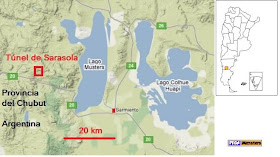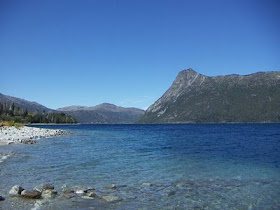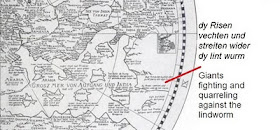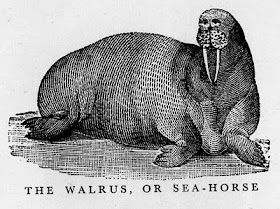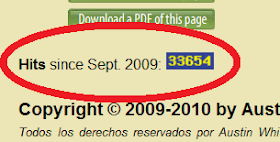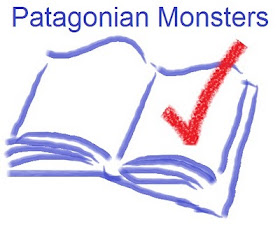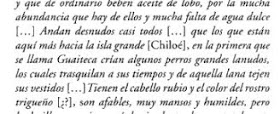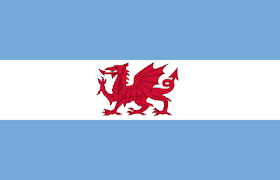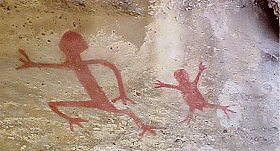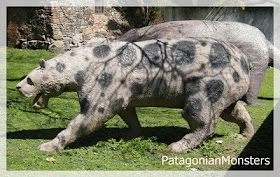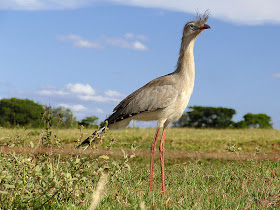Mapa showing current distribution of the peccary in America and its probable former distribution in Patagonia. Copyright © 2010 by Austin Whittall
Peccaries (Tayassuidae) are very similar to the Old World pigs (Suidae). They came to North America from Asia and then spread into South America some 3 Million years ago when north and south America joined.
It is an extremely adaptable animal and the fossil remains of a peccary have been found in the Great Lakes region of North America, the Platygonus compressus, which fed in the grasslands "near the edge of the glacier", that is, in a very cold and harsh climate. It also lived in South American during the Pleistocene. This Platygonus was the largest of all peccaries and had the size of an European wild boar. [1]
Patagonian Peccaries
¿Could it have lived in Patagonia at the end of the Last Ice Age?
Intriguingly, a source,[2] states that "Catagonus is a genera related to the Platygonus [...] which during the sixties has been found alive in Patagonia" . This is surprising since I have not found any records or references about it. Furthermore there are no peccaries in Patagonia nowadays.
Regarding the Catagonus (Catagonus wagneri) it was believed extinct until it was rediscovered in Paraguay in 1972. It is currently restricted to the dry Chaco region in Bolivia, Paraguay and Argentina. [3] It is the largest surviving member of the peccary family and can weigh up to 35 kg (70 lb) and measure over 1 m (3.3 ft.) long. In its curent arid habitat it eats cacti.
No peccaries are found beyond this area. Well to the north of Patagonia. Nevertheless we have some clues that lead us to believe that they did inhabit Patagonia in relatively recent times. Lets see the proof:
- The northern Tehuelche lived in the area between the rivers Chico and Chubut in the south to the Negro River in the north, and outside of Patagonia they could be found in La Pampa and the province of Buenos Aires, They had a word in their language to name the peccary: Olasiq. This word does not seem to have been taken from any other language and has no equivalent in Spanish or Mapuche it must therefore refer to a native "pig". It could also refer to wild or feral Old World pigs.[4]
- In 1876, Francisco Moreno mentioned the "pachyderms" in the forests close to Lake Nahuel Huapi which he did not see, but based on the native's description thought they could be "forest pigs" or peccaries.[10]
- In that same area, in 1862 Chilean explorer Guillermo Cox said he had noticed wild pigs on the shores of Limay River. [11]
- The native path used by Tehuelches and Mapuches that joined Valcheta with the Negro River at Carmen de Patagones through San Antonio Oeste, was known as the "Pigs Road" ("Camino del Chancho").[6]
This seems to indicate the presence of peccaries, at least in northern Patagoina. I show this in the map (above) where in yellow I mark the current range of all peccary species and in green, only for Argentina, their probable distribution in until the ninetheenth century.
It is possible that they had extended their range into southern Patagonia because we have reports on pigs there:
Captain FitzRoy, commander of the HMS Beagle sailed along this region between 1826 y 1833, and recorded that the natives:
were much frightened by sheep and pigs. They would not land on a small island where some pigs were turned loose, and when talking of them, made signs that they had very big noses which alarmed them. When a pig was killed by the crew and part of it cooked, the natives refused even to taste the meat.[12]
Also at the straits of Magellan, in 1593 Sir Richard Hawkins reported something very similar to the pig-like tapir: “Hogs […] here we saw certaine Hogs, but they were so farre from us, that we could not discerne wether they were of those of the Countrey, or brought by the Spaniards”.[13]
Ned Chace, an american who lived in Patagonia between 18981 and 1930, also wrote about giant pigs in southern Patagonia (beyond 48°S):
A friend of his had followed a track [...] until he caught sight of what he took for a hairy pig as big as a bull. Just a glimpse he had. [14]
Taboo
According to the jesuit father Strobel, in 1740 there was a taboo among the northern Tehuelches and the Pampas or Puelches:
They do not eat pork and asking one why, he answered that those animals had been at one time bad men that then became pigs. [7]
This is similar to a legend compiled by folklorist Bertha Koessler Ilg, which mentions the creation of pigs as a punishment for some men and additionally that for this reason their meat could not be eaten and that in summer: "your flesh will be harmfull because it is poisoned".[9] The Tehuelche myth in northern Patagonia is evidently of Mapuche origin (due to the Araucanization of the Tehuelche: the Mapuche progressively extended their influence eastwards towards the Pampas, and through war, trade and cattle rustling, absorbed and Araucanized the original Puelche inhabitants of Tehuelche blood during the eighteenth-and nineteenth-centuries).
But, in the deep south of Patagonia, the Aonikenk, towards the end of the nineteenth century, according to explorer Ramón Lista "Do not eat fish, nor pork. These two animals are considered disgusting, and show for them an insurmountable repugnance", which he believed was due to some taboo regarding their god Elal. [8] This aversion is very similar to the one mentioned by FitzRoy.
These myths may indicate a widespread animal similar to a pig within Patagonia.
We have found, besides the word Olasiq [4] mentioned above, another one, which according to Casamiquela, was used by the northern Tehuelche to name the peccary kúcha which he believed was due to the snorting sound it made.[6] I disagree with this interpretation. -It is clearly (see following image) that the word comes from the Mapuche language spoken at Chiloé (and apparently from Quechua too) who called the pig cuchi because it was the word used for dirt:
Cuchi word used for pig in Chiloé. Copyright © 2010 by Austin Whittall
According to Casamiquela [5] the Mapuche called the collared peccary "sañwé" (pronounced shañwé). But again I believe he is mistaken as this is not a native word, father Augusta's dictionary [12] has an entry for "swine: sanchu, sañ:we", and the same for pig (in Spanish "chancho") [12] which is without doubt the word from which the Mapuche one comes from (chancho - sanchu), as both have the same sound. The word is of Spanish origin.
Tapir or peccary?
Why would the natives have a taboo against eating pork? (We will not suggest silly ideas such as the Patagonian natives belonged to the lost tribes of Israel -amusing and interesting which I may look into later).[16]
It is a question for which we do not have an answer, but it is likely that Patagonia was home to a big animal (the giant pig seen by Chace's friend), one that provoked fear in the natives (as mentioned by FitzRoy), a monstrous pig or something similar.
It is likely that there were no peccaries in Chile (that is why I did not paint Chile green in my map above), and that they only came into contact with the Spanish pigs after the conquest.
But the northern and southern Tehuelches did know a local native animal resembling a pig. Maybe it was a peccary, or it could have been some other animal such as a tapir.
Bibliography.
[1] J. Alan Holman. (1995). Ancient life of the Great Lakes Basin: Precambrian to Pleistocene. University of Michigan Press. pp. 198
[2] Eudald Carbonell, (2005). Hominidos: Las primeras ocupaciones de los continentes. Editorial Ariel pp. 617
[3] Maffei, Leonardo, Cuellar, Rosa L. y Babegas, Jorge. Distribución del solitario (Catagonus wagneri) en Bolivia. Geographic distribution of Chacoan peccary (Catagonus wagneri) in Bolivia. Ecología en Bolivia. [online]. ago. 2008, vol.43, no.2 , p.141-145.
[4] Mariano Martín Fernández El pecarí de collar. Chancho autóctono de La Pampa
[5] Casamiquela, R. (1968). Geonimia: obra mapa de La Pampa. Biblioteca Pampeana, pp. 25
[6] Relaciones de la Sociedad Argentina de Antropología, Volúmenes 8-10 (1974), Sociedad Argentina de Antropología. pp. 114-115.
[7] Furlong Cardiff, Guillermo (1938): Entre los pampas de Buenos Aires. Buenos Aires: Talleres Gráficos San Pablo. pp. 97
[8] Lista, Ramón, (1998) Los Indios Tehuelches -Una Raza Que Desaparece. Ed. Confluencia. pp. 72
[9] Bertha Kössler-Ilg, Rolf Foerster, (2006). Cuenta el pueblo mapuche: Cuentos y fábulas. vol .iii. MN Editorial. pp 238
[10] Moreno F., (2007b). Exploración de la Patagonia Sur I-Por las cuencas del Chubut y el Santa Cruz: 1876. B. Aires: Continente pp. 73.
[11] Cox, G., (2006). Expedición de la Patagonia Norte: un viajero en el Nahuel Huapi: 1862-1863. B. Aires: Continente-Pax. pp. 194.
[12] FitzRoy, R., (1839). Narrative of the surveying voyages of His Majesty's Ships Adventure and Beagle between the years 1826 and 1836… London: Henry Colburn.
v. ii. pp. 195 - 6.
[13] Purchas, S., [Comp], (1625). Haklvytvs posthumus or, Pvrchas… London: H. Fetherston. v. 4. pp. 1384.
[14] Le Moyne Barrett, R. y Barrett K., (1931). A Yankee in Patagonia, Edward Chace. Boston: Houghton Mifflin. pp. 29-30.
[15] Augusta, F., (1916). Diccionario Araucano - Español y Español - Araucano. Santiago. Impr. Univ. pp. 97 y 208.
[16] Bernardo Graiver, (1980). Argentina bíblica y biblónica: historia de la humanidad en la Argentina bíblica y biblónica. Editorial Albatros. Also see Enrique García Barthe (Online).
Lea este post en español
Patagonian Monsters - Cryptozoology, Myths & legends in Patagonia2010 International Year of Biodiversity Copyright 2009-2010 by Austin Whittall ©



